Cris Sommer Simmons was the only American woman riding in the Motorcycle Cannonball Endurance Run that wrapped up September 26, 2010 in Santa Monica, Calif. Cris finished 20th overall. She spoke with me by phone three days after her history making ride from her home in Hawaii where she was relaxing after riding her 1915 Harley-Davidson across the country. For background details on the ride and to put this interview in perspective, visit WRNs news story on the event, then come back and read Cris first interview after the ride. Thank you to Kevin Beanre who supplied most of these photos, and to Laura Klock for photos as well.
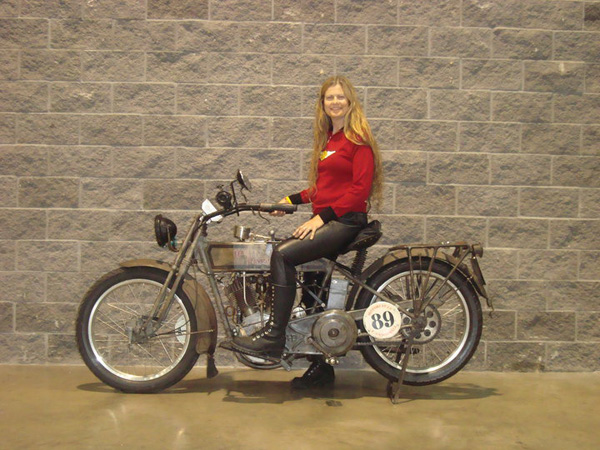
Genevieve: Now that the Cannonball Run is over sum up your feelings on it.
Cris: It’s hard to sum it up really. It was one of the most incredible experiences of my life. It was hard, but the camaraderie and the friendship of the riders helping each other was amazing. That’s something I’ll take away the most.
What was amazing was the teamwork of everybody helping each other. Like I broke a pushrod and someone was there to loan me one. Somebody else’s mag went out and I had a spare with me. I could have kept going because it was early on and you think what if mine breaks, but then how can I just sit there early on with one in the truck if this guy is going to be out. That’s what it was like. Everybody was helping everybody. People were working until two or three in the morning helping their friend rebuild their bike so he could ride the next day. To me, the whole spirit of the Cannonball was the camaraderie. It was just amazing.
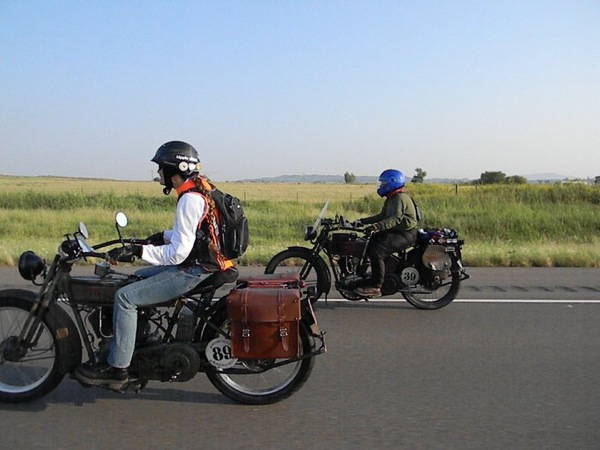
G: Were you surprised by the camaraderie being it was a competition?
C: I was surprised and I wasn’t surprised. I hoped this is how people would be. Everybody was like that. Everybody was helping everybody.Everybody was over there getting their hands dirty. They could have gone to bed. It’s exhausting getting up at six or seven every morning and then riding in the hot sun. You have to stop every 60 miles for gas. It’s tough. Sometimes that’s when the bikes would break, when they stop, so it’s good to keep going if you can. By the time you get in, you need to get a little dinner if you’re lucky and then you have to service your bike for the next day, which means adjusting all your chains, there were people changing tires, people ripping apart whole motors in the hotel parking lots. I was amazed.
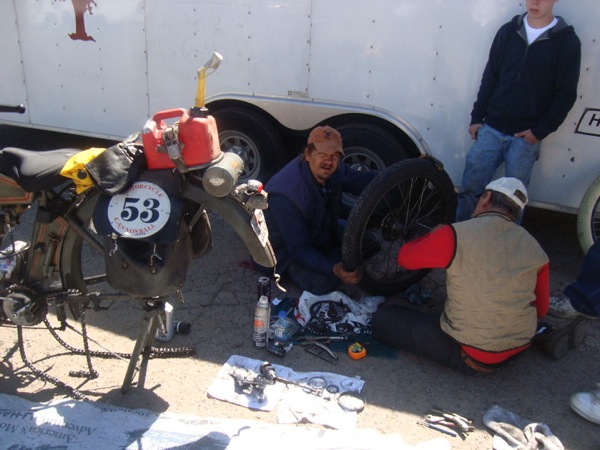
G: You and I have been to a lot of women rider events and we’ve seen that same kind of camaraderie of helping each other at events and competitions. I hate to compare men to women here, but I have to ask, were you surprised since there was mostly all men competing that they were willing to help one another, or do you think they were like that because it’s the vintage crowd, which is a niche crowd within motorcycling.
C: Yes. The vintage thing is totally different. These motorcycles are 95 years old and older and to just keep them running was amazing to me. Just to see bikes you may have seen in a museum that you’ve never heard run, just the difference between a Merkel and an Indian and an Excelsior, to hear them was totally amazing.
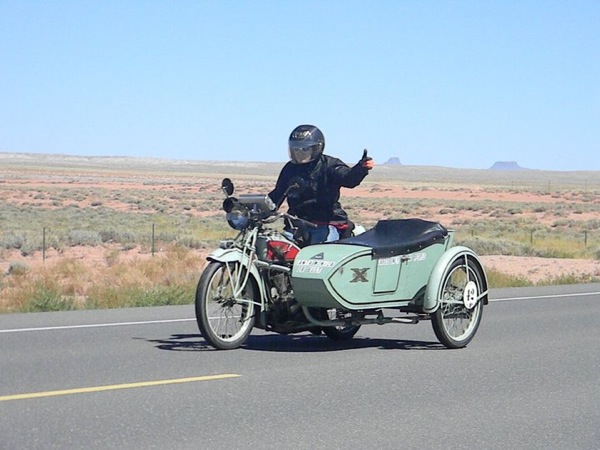
G: Tell me some details of your day, the hours you rode, how many miles, etc.
C: I usually left around 8:00 a.m. That’s when my class, class 3, which is the faster bikes, left. We didn’t get to leave at seven like the single cylinder bikes. My day would consist of basically just trying to make it to the lunch stop. The first two days I didn’t get lunch because my bike wasn’t running enough.I had so many issues on the road, trying to start it. It was just tough the first few days getting into a rhythm. So basically I rode all day until 4:00 because they had a rule that if you didn’t get there by a specific time you’d get a “do not finish.” You wouldn’t get your miles. Then they changed that after the first three or four days because these people are trying so hard and they’re breaking down, and what if they get there 10 minutes late, they’re not going to get credit for what they did all day? So they had a bit of a rule change. Some guys were like, “Hey, the rules should be what the rules should be.” Other guys were like, “I’m riding a single cylinder bike and I’m out there eight to 10 hours a day and what if I break down 10 miles away, my bike doesn’t count?” So they changed that which I think was fair.
I’d get in around 4:30 to 5:00. A lot of times we had to stop at Harley shops for hosted dinners. We couldn’t go to the hotel. We’re riding all day and we’re dirty and sweaty and grimy. But we had to go to these Harley dealerships, which is wonderful because everybody wants to meet you and say hi and pose. Maybe there’s food you can eat. Hot dog and hamburgers most of the time. They you try to get over to the hotel to service your bike by 6 or 6:30. And that could take hours because you have to adjust the chains every night. You have to pull the primary cover off and adjust the rear chain. Have to work on the lifters, pushrods, everything. Fill it up with oil; fill it up with gas. Got to check every nut and bolt because things get loose when you’re riding. Youre riding your bike without shocks. It’s a rigid frame and the roads are so bad. Some roads were great. It was extremes. Really good and really bad.
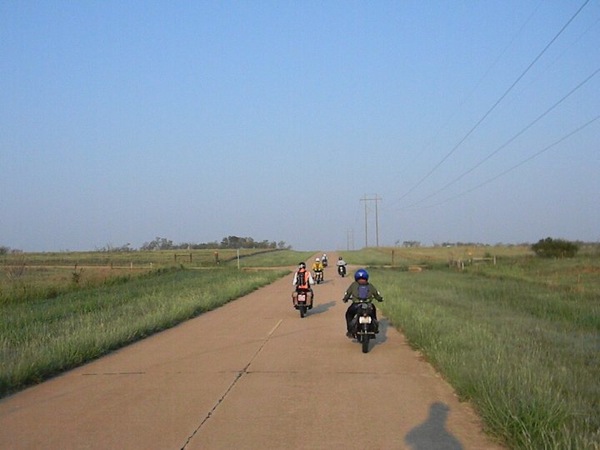
G: This was truly an endurance run. You and your bike were pushed to its limits each day, huh?
C: Oh yes, the first couple nights I got only five hours of sleep. Some guys got less; some guys got more. Just depended on what your bike needed. Sometimes you’re helping somebody out, so you’re trying to find parts for someone, just hanging out. You’re so caught up in the moment, you couldn’t sleep. Just excited to be there and meet everybody. And then maybe get to bed by midnight and get up again at six and do it all over again.
I had to pace myself. The first few days my bike really wasn’t broke in enough. I realize that now. I only had 400 or 500 miles on it. The rings hadn’t even seated yet. I had power trouble getting over hills. I couldn’t keep up with people. It was kind of frustrating for me. You see everybody else going fast. A lot of those guys had bored out motors. I had a stock motor. So I said, OK this is the way it’s going to be. So you just take your time.
I rode by myself the first few days, which is kind of weird because I had a hard time getting the bike up on the rear stand. I’d be at a gas stop and say c’mon over here, can you help me get this up?
I told you I had a rough start. I was at a gas station with a bunch of other Cannonball riders and some lady came up and parked on my foot—on my heel—with her SUV. She was looking at the motorcycles and she got really close to me. I had to scream at her to get off my foot. She parked on my heel. She didn’t break anything. I had a really swollen leg and a really badly bruised foot, which sucked the whole ride. And then I had a multitude of other bruises because when you kick start these bikes sometimes they kick back.
G: What was your average speed?
C: 45 was my average speed.
G: How did that feel since you’re more accustomed to riding a faster modern motorcycle?
C: You got into a rhythm. It’s called finding the sweet spot. You don’t want to push these bikes. You have to make it go all the way across the country. A lot of guys did that, they rode the heck out of them then they’re ripping the heads off at night and rebuilding the motors in the parking lot with lights on and generators. A lot of people had welders.
I teamed up with a guy named Jim Petty who rides a 1915 Indian out of South Carolina. We kept bumping into each other so we started riding together, and he helped me. I ended up helping him too on the side of the road a few times because I had some parts he needed like cotter pins one day. Then he was out for two or three days because he broke a valve cover. It just broke from getting hot. The metal is 95 years old! Nothing he did. It just broke. So he had someone machine him one, then he got back in and we ended up finishing the last two or three days together, which was cool.
G: What was your reaction to seeing all the people who came to meet you at the overnight stops?
C: Amazing. People would drive hours and hours, the whole day to come and see us. It was cool for me. Motor Maids were at almost every stop. They were amazing. A lot of them were in Kitty Hawk for the big send off. There were like 20 or 30 at one stop. We had one day off in Hot Springs and they actually sent a massage therapist to give me a massage.
G: The Motor Maids did that?
C: Yes. They’d bring me stuff—little gifts and trinkets. I came home with all kinds of things in my backpack.
G: How did you deal with the heat riding through the south?
C: I wore a Camelback when I rode to drink water, which was my best friend because it was hot. Very hot and humid in the south going through Alabama. Then we got out west and it was really hot in the desert before we got to Santa Monica.
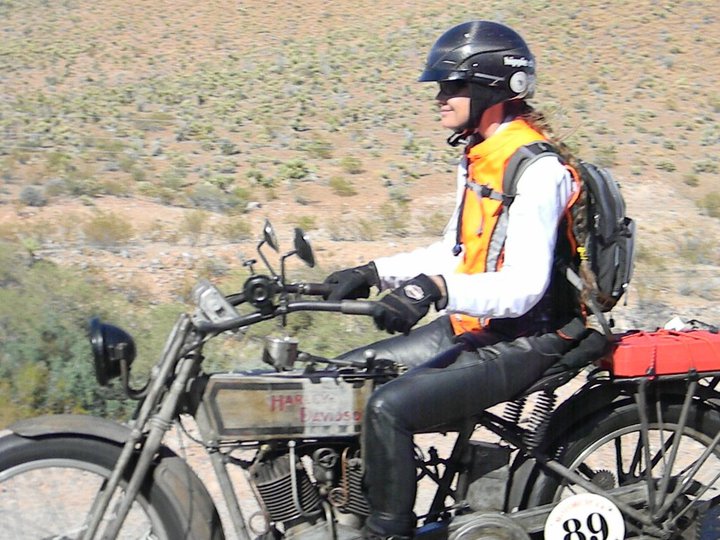
G: When you decided to do the Motorcycle Cannonball Endurance Run, did you expect it would turn out to be the big event it did?
C: I knew it was a big deal, being around the antique world. Nobody has ever done something like this before. We have a little ride out west that’s maybe 50 miles that’s held once a year, but nobody’s ever tried to take the bikes cross country. I knew I wanted to be part of it. I thought 200, 300 miles a day, that’s nothing, because you know how we are on our big bikes, we can do 500, 600, 800 miles even, without a problem. I’ll tell you, it’s different because you’re going slower and you have to stop every 50 or 60 miles. You have to check stuff; the bikes run really hot. I had to wrap my right leg because the rear cylinder was burning my leg.
G: Any special moments along the way?
C: There was a time when I was on the Natchez Trace Parkway and there were no other cars, it was just me. I thought this could be 1916. And going through these little towns, the people just came out in droves. We’d be having lunch at some café, some little tiny town with not even one stoplight and people are just coming in to meet us. Like the lady from the local newspaper sat down and said, “Hi I’m from the local paper and why did you come to our town?” That was so cool. That happened a lot. I told people it was like a traveling carnival going through each town with all these antique bikes.
G: Let’s take it to Effie Hotchkiss and all the women you wrote about in your book, The American Motorcycle Girls: 1900 to 1950. Do you have a new appreciation for what those women riders dealt with back in the day?
C: Oh yes definitely. You had to be quite the mechanic to keep your bike running. It took Effie two months to go cross country; it took me 16 days. Definitely an adventurous spirit she was. It was different back then. But then they didn’t have semi’s bearing down on them going 70 mph. There were a few places where we had to get on the freeway and that was really something. I was actually worried about that, but then when I got out there I wasn’t because they could see me. I had on a bright orange vest.
G: Did you ever have any fear or anxiety during the ride?
C: Oh yea. I had butterflies every morning. Is my bike going to run today? The parts are so old. They’re 95 years old. They wear out. There were times I was scared. I was all by myself. What if the bike would have died? I would have been sitting there waiting for someone to help me. I kept thinking about Dot [Robinson]. Louis Sherbyn and everybody. Definitely Avis and Effie Hotchkiss. I think they were all with me. [Editor’s note: These are some of the pioneering women riders Cris writes about in her book.]
G: Tell me your thoughts on Team Effie, the women who assisted you?
C: I am so lucky with Team Effie—Laura Klock, Athena Ransom, and Toast Boyd. All Motor Maids. Team Effie was great. When I came in, they’d hand me water, take my jacket off, make me sit down and I’d go and take a shower and they’d start working on my bike every day. The first few days they would go ahead and meet me at the hotel because the rules didn’t allow the chase crews to follow us. They didn’t want a bunch of trailers and trucks on our route, but after the first few days they needed more people to act as sweepers. We had a van so we could pick up a bike. Plus Chickie [Athena Ransom] is a great mechanic. Laura’s a really great mechanic too. They would leave after the last bike and if anybody was pulled over, they’d stop and help them. They wanted to do that because they’d be at the hotel pacing waiting for me saying, “Where is she? Where is she?”
When they were out in the field, they’d see me and help me, which they were allowed to do. They picked me up one day because I had a broken push rod. I couldn’t find one so I missed miles that day. And another day I had a flat tire in the rear 12 miles from the hotel. So I missed miles that day and someone else picked me up that day. But the girls did great. They helped so many people. They helped three or four guys get back on the ride and were able to finish because of them. I’m really proud of Team Effie. Everybody loved Team Effie because we’re girls. We were always so nice to everybody. We were always happy and helpful.
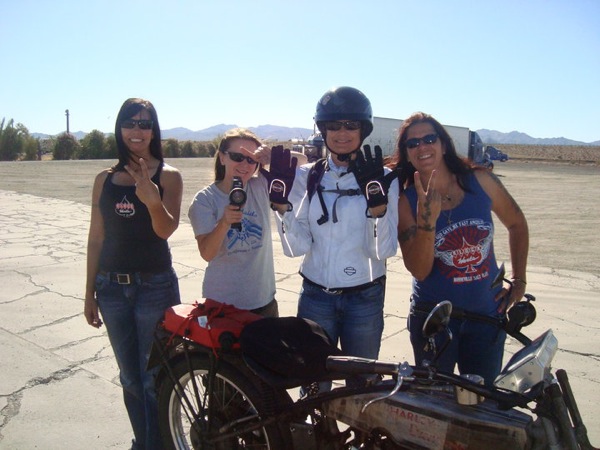
My daughter Lindsey was there at the beginning and helped out and thenmy husband, Pat, joined us on day four and went for the rest of it. Hebecame like the Charlie of Charlie’s Angels. I could never have donethis without the support of my husband and kids.
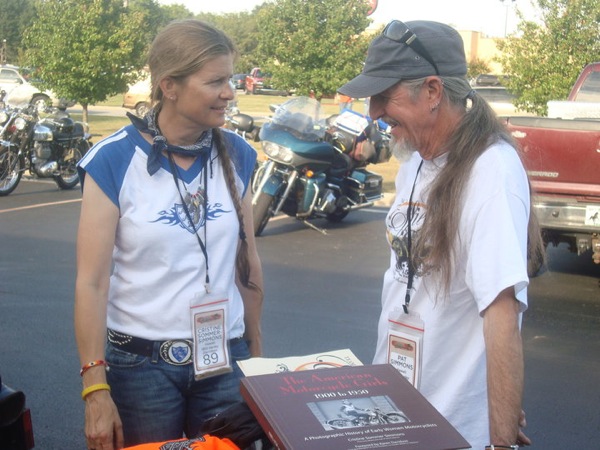
G: What are your plans for chronicling the ride?
C: I’m going to do a book. I’m going to start working on it probably this week. I’m going to Europe with my husband who is playing over there and I’m going to take my computer and start working on it. And we filmed everything, which was Toast’s job. Discovery was there filming it too. I took water out of the Atlantic at 6:30 in the morning at sunrise the day we left Kitty Hawk and we filmed that and then we filmed me putting the water in the Pacific in Santa Monica. I walked down to the beach and I poured out the water. I couldn’t let go of all of it though. I had to keep some. So I poured out half and I scooped up some from the Pacific mixing the two waters together and I have that jar on my desk. [Editor’s note: The cross country water carry is the same thing Effie and Avis Hotchkiss did on their 1915 cross country journey.] I’m in touch with their great nephew, Craig, and he’s really excited I did that.
To me finishing was winning. I didn’t really care about the points. It’s pretty cool. I’m happy I did it. I’m glad its over, but I’m sad it’s over because everybody just bonded every day.
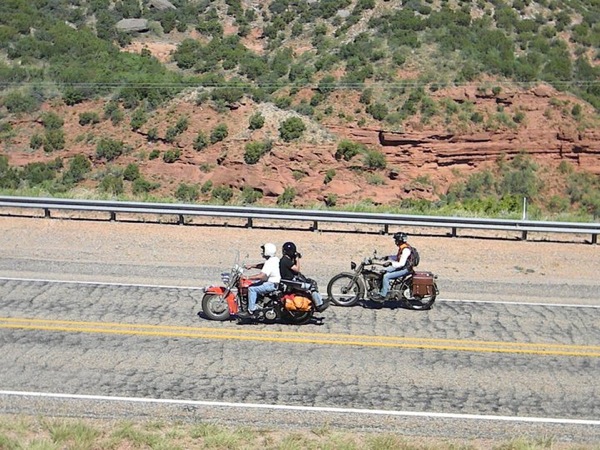
G: Thanks Cris.

Boy what an interesting ride! I went on a 17 day adventure out west and north in June 2009 with my riding buddy 74-year-old Walter Kinchen. Rode the Beartooth, Milwaukee Museum, Kansas City Factory, and the Dragons Tail on the way home. Mostly back roads, little towns, crossroad stores. Met the most interesting people. No major breakdowns. Maybe Maine this summer!
Amazing. Truly inspirational!
Awesome!
This is an awesome story and challenge! I own a ’68 ironhead Sportster and know what a beast it can be at times. Nothing like a 1915 for sure! I certainly relate with Cris’ feelings of “am I gonna get home on this thing?” But also know the satisfaction and charm that old iron brings. Way to go keeping history alive!
People helping people in a ride like this is very necessary. It still goes on a lot with bikers; not always, but it does. I rode with an antique club. These people are special. They love what they ride and they’ll help anyone when they can. This gal is awesome. The article was great. Can’t wait to read this book.
Cris is such an inspiration, not just as a biker woman, but as a humanitarian. She cares and it shows. It was wonderful seeing her on the other end of this endurance challenge, coming out victorious and humbled.
What an amazing journey. I can only imagine what it was like to be part of such a historical event. The camaraderie, the sights, the people who came together and made this happen. Also a lifetime of memories for everyone involved, including all the towns, and people on the road witnessing this event in front of them. This is what America is all about. If only we could get Congress to do something like this we might have a chance to turn this economy around.
I think this is absolutely amazing that these people could ride and fix these old bikes and ride that far. Cool!
Wow. Wonderful. I love to see people riding the old bikes. I keep my old lady’s on the roa, too. So, have fun and hold on to the wonderful moments.
Oh my aching butt. You folks are incredible to have ridden in that heat. I figure you guys were riding in, at least, 102-degree asphalt roadways, maybe even hotter. When I get to a stop sign here on the east coast in the summer and the sweat is dripping down my face I say to myself “go home and put the AC on.” But you start moving and that is just a thought. Glad to hear you all made it there safe. Thanks for sharing with us
Cris did an awesome job! So much to do in this race, and having to lower your pace from standard riding, but she is a very competent rider, and knew Effie inside out. She’s a remarkable woman, in so many respects. I’m a real fan. Hugs to you Cris!
Awesome!
Genevieve, Thanks for catching Cris for this interview. What a thrilling adventure with a wonderful cast of characters!
Impressive journey. Wow…great to read. Small towns on a bike is what it’s about.
Wow! What a testament to the sturdiness of these old bikes and the courage of Chris and team Effie. To undertake such an event, one would have to be smart, fit, mechanically inclined and determined. Chris and her entire team has earned a spot in my hero book. Job well done ladies!
Am so very proud of my daughter, Cris. She has always been a winner, and strives to be so fair and caring to so many people. Am so happy she helped so many other riders in the race, just like they were there for her when she needed them. Fair and square, and so beautiful in her spirit as well, and in all that she does. I love you, Cris.Your own lil Momma Chiki
Yeah Cris and Team Effie! Motor Maids rock!
I’m really impressed with Cris and all the women who came before her who show all that women can be